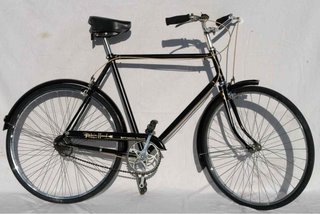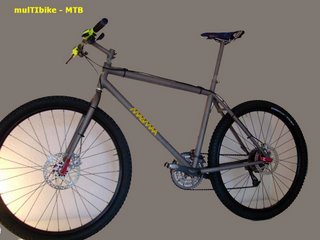One more reason for a beater
 This beauty (a 1960 Raleigh, of course) will probably cost you $70 if you get it at a yard sale or bike co-op. Throw in the replacement parts such as new tubes, brakes, cables, and a decent seat. Then you'll probably spend $150 tops.
This beauty (a 1960 Raleigh, of course) will probably cost you $70 if you get it at a yard sale or bike co-op. Throw in the replacement parts such as new tubes, brakes, cables, and a decent seat. Then you'll probably spend $150 tops. In contrast, this Swedish titanium and carbon-fiber doo-hickey will set you back anywhere from $1500 to $2500. Don't even get me started on maintenance, parts, spiffy lycra outfits...
In contrast, this Swedish titanium and carbon-fiber doo-hickey will set you back anywhere from $1500 to $2500. Don't even get me started on maintenance, parts, spiffy lycra outfits...Now the good news is that bike sales are booming in North America. To quote Paul Glader who writes for The Wall Street Journal,
But the bad news is that what I call exotic materials are shifting new bike prices higher. According to Paul,About 19.8 million bicycles were sold last year in North America, up 8.2 percent from 2004, according to the National Bicycle Dealers Association. Sales of bikes and bike-related parts topped $6 billion last year, up from $5.7 billion in 2004. Some bike makers estimate that 30,000 cyclists each year spend $3,000 or more on a new bike, a $90 million market.
This basically means thatA booming aerospace industry is bringing bad news to cycling enthusiasts by sparking higher prices for fancy bikes. This means bike makers -- along with makers of sailboats, lacrosse sticks, tennis rackets, jewelry and bone screws -- are paying 25 percent more for raw materials and passing along costs to consumers.
Prices for high-end bikes from makers such as Trek Bicycle Corp., Cannondale Bicycle Corp., and Serotta Competition Bicycles, some of which already cost more than $10,000, could rise 5 percent to 25 percent.It's not only the materials which are responsible for SUV-priced bikes:
And I thought prying open my Sturmey-Archer 3speed hub was a modern technological feat. In any case, thank g-d for the resourceful American consumer.But the growth also reflects the ever-escalating upgrades in bike models. Bike makers now use laser measurements, computer simulations, test-ride videos and drawings of a rider's body dimensions to create a more perfect ride. The desired growth in sales, coupled with tightening demand for raw materials, puts the bike industry in a bind.
Others are not so sanguine.Some wealthy cyclists, however, say they don't worry much about escalating prices for bikes. John Machette, a consultant for Accenture Ltd. in Chicago, says he keeps bikes at his apartments in Houston, Chicago and Washington, D.C., where he travels for work. Still, he bought a $1,200 Trek 1500 road bike recently to keep in Washington, rather than paying $5,000 for another model.
Got that? He SAVED money by spending ONLY $4000.Some consumers such as Jamie Hintlian are beating the increases. Hintlian, a 46-year-old pharmaceutical-industry consultant in Boston, rides about 3,000 miles a year, owns half a dozen bikes made of various materials and keeps his eyes open for new bikes and parts. Hintlian bought a $4,000 bike made by Seven Cycles Inc. this summer to beat the expected price rise this fall, saying he's noticed that prices tend to increase annually. "I'm not going to go over the top for the sake of having the latest and greatest at any expense," he says.
But bike makers believe high prices eventually will hurt sales for middle-class buyers and could cause a return to other, cheaper materials such as lightweight steel. Cheaper bikes at retailers such as Wal-Mart Stores Inc. are typically made of steel.Do the math: at the top end of the marketplace the bikes will continue to be astronomically expesnive. At the bottom end the affordable bikes, thanks to the box stores, will get crappier and crappier.
 And in between? Get a beater, you'll never regret it ... if you live %)
And in between? Get a beater, you'll never regret it ... if you live %)Labels: Chicago, that which rolls, velopunk







0 Comments:
Post a Comment
<< Home